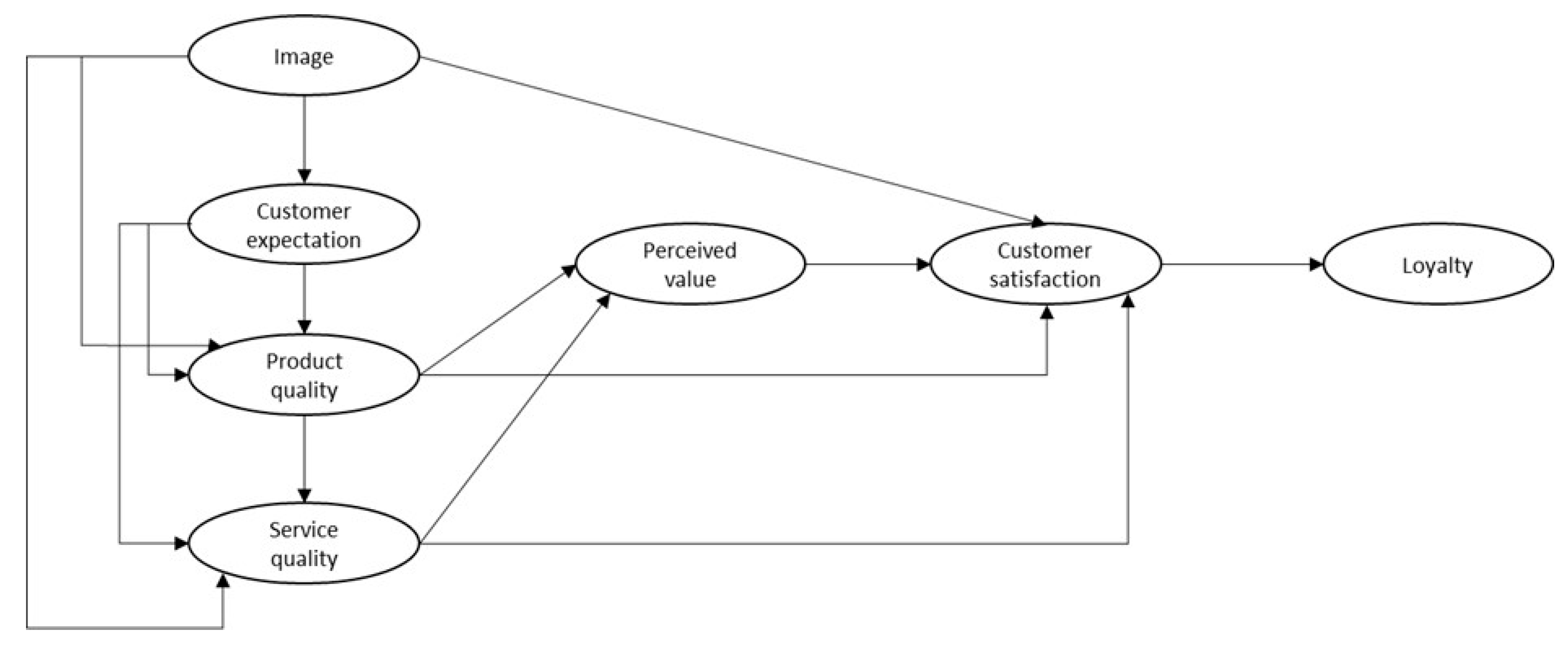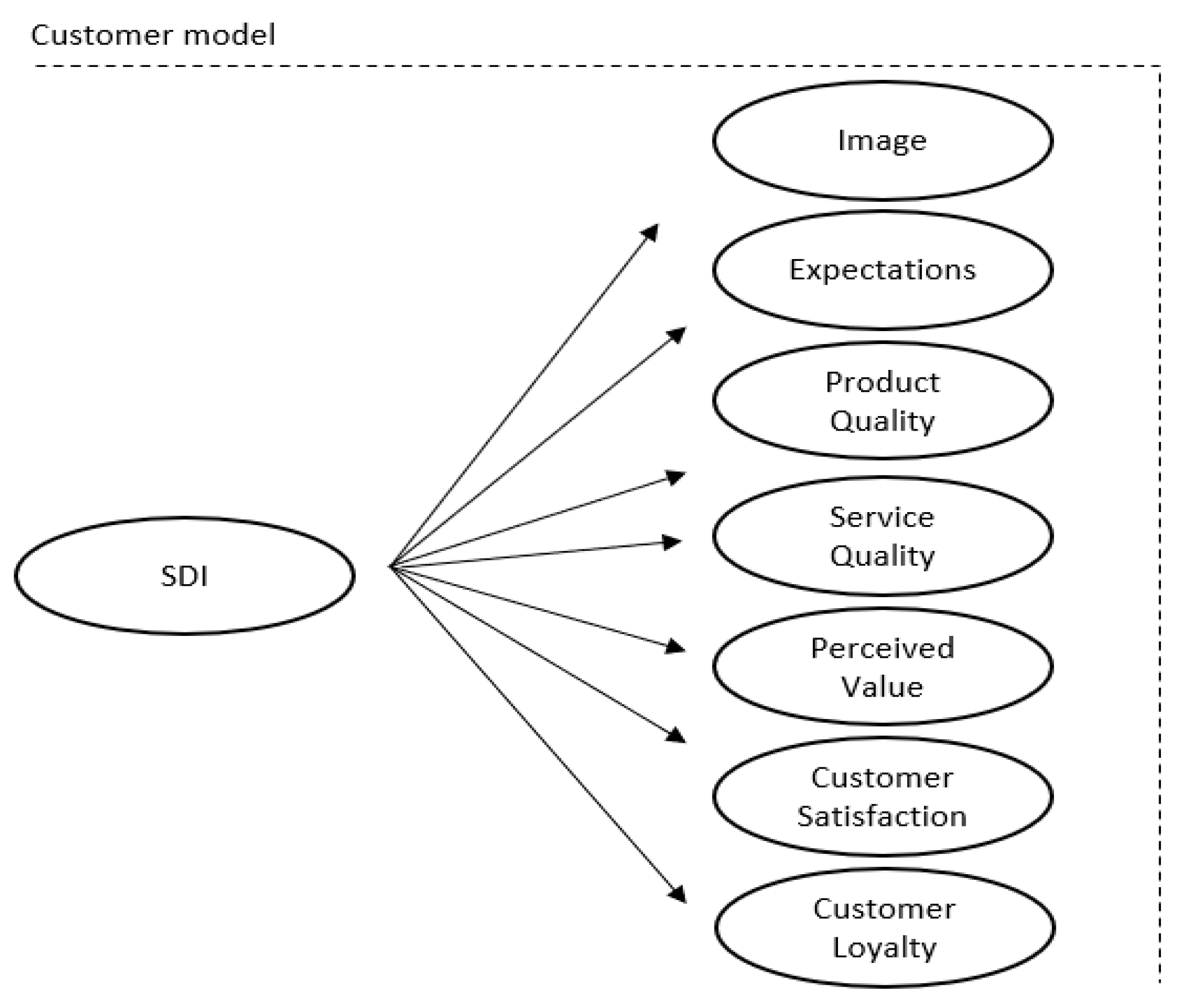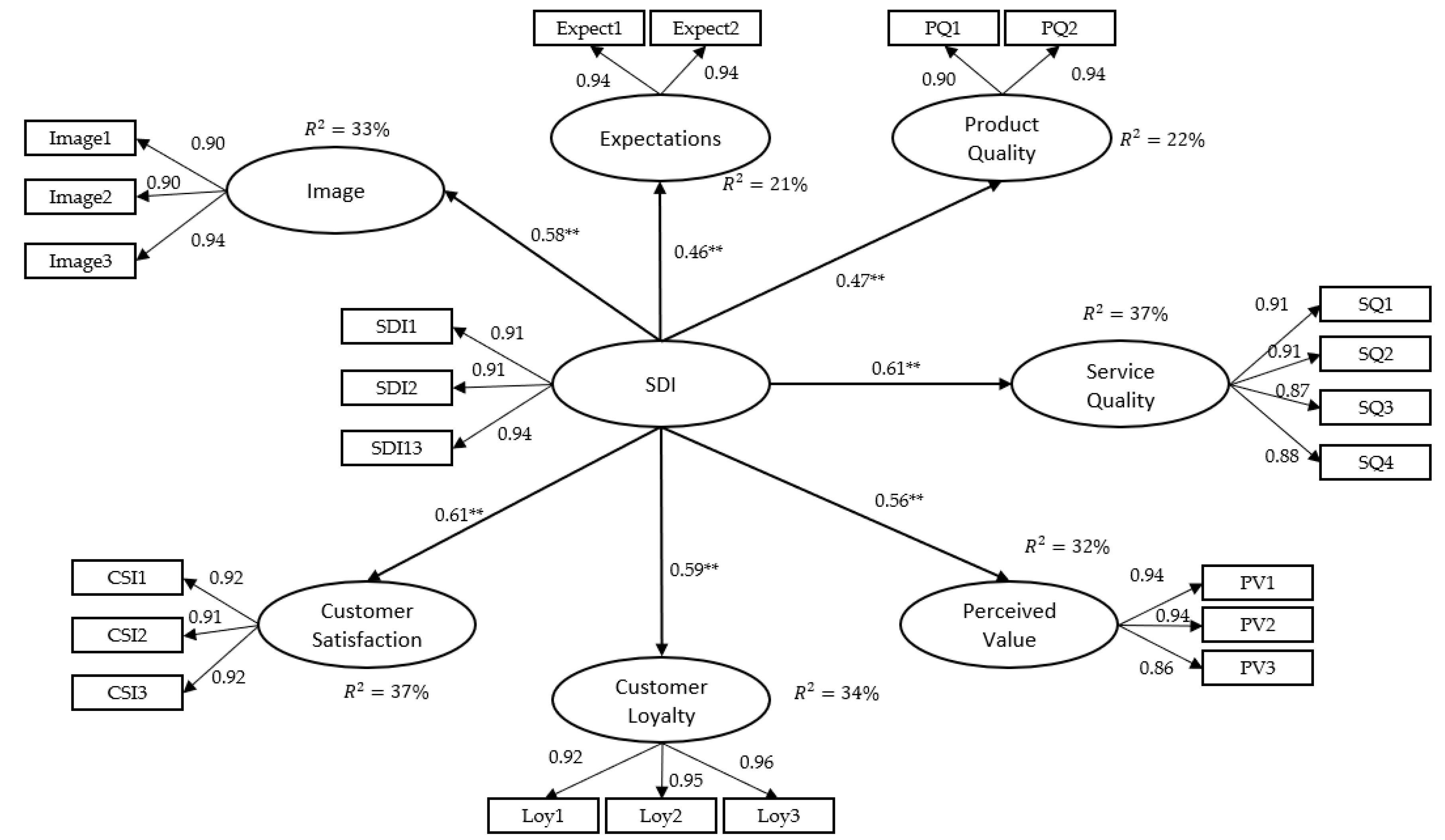1. Introduction
The concept of sustainable development (SD) has been on the global agenda for fifty years and is now widely accepted among nations, organisations, and individuals alike [
1,
2,
3,
4,
5,
6]. According to the Brundtland Commission, SD is defined as a development that meets the needs of the present generation without compromising the ability of future generations to meet their needs [
7]. Theoretical perspectives of SD have been broadly discussed and applied, including several different requirements for what should constitute a sustainable organisation [
8,
9,
10,
11]. However, despite decades of research, there is a need for further studies on the integration of SD with core business measurements and processes [
12,
13,
14]. Simply put, there seems to still be a gap between SD theory and practice [
2,
13,
14].
Elkington, Topfer, and Walker presented the concept of a triple bottom line (TBL) to compliment classical management focus with three SD dimensions [
15,
16,
17]. Thus, a single bottom line of financial performance was extended to include economic, environmental, and social performance. The TBL approach has become well-known and widely used as a framework for SD measurement and management in organisations [
1,
4,
5,
6,
18].
In short, the three TBL dimensions can be described as follows: The people or social equity bottom line refers to fair business practices towards labour and the society in which an organisation is operating [
19]. The success and well-being of the organisation, its workforce, and other organisational stakeholders is interdependent. As such, organisations complying with TBL seek to contribute to the overall strength and growth of its community.
The planet or environmental bottom line refers to development where ecologically destructive practices should be avoided. Organisations which have adopted the TBL may focus on reducing its ecological footprint by managing its consumption of energy, natural resources, as well as non-renewable inputs and outputs [
20,
21,
22].
The profit or prosperity or economic bottom line deals with the economic value created by an organisation. In the TBL concept, the economic value created, or the profit itself, needs to be evaluated from the perspective of society as whole. Therefore, in a TBL approach, the economic bottom line is arguably not to be interpreted as traditional corporate accounting measures. However, in practice, the economic TBL dimension is generally reported within the frameworks of classical financial reports [
14].
There has been significant progress in mapping positive attributes from stakeholders regarding SD. Research has found that organisations which are successful in communicating adequate SD policies and initiatives may evoke several positive attributes. For example, organisations perceived as sustainable gain attractiveness and retain employees [
23,
24]. SD efforts have also been found to enhance reputation and brand image [
25,
26]. Moreover, it has been shown that customers positively affected by perceived SD show increased loyalty [
8] and satisfaction [
26,
27], which in turn influences the organisations financial results [
13,
27,
28,
29]. Despite this progress, SD models are still complex and difficult to implement. Therefore, there is a need to make SD more understandable and workable for everyday business life [
8,
13,
14], especially regarding customer perceptions.
The purpose of the study is to estimate a Sustainable Development Index (SDI) as a reflective aspect capturing customer perceptions of intertwined SD dimensions and to estimate SDI effects on EPSI Rating variables. EPSI Rating, formerly known as the European Satisfaction Index, is a well-known adoption from the Swedish Customer Satisfaction Barometer [
30,
31]. The EPSI model framework encapsulates the customer experience into five drivers of brand image, customer expectations, product quality, service quality, and perceived value which creates customer satisfaction and loyalty. As suggested in the literature, a significant relationship between SD and other variables measuring customer experience is expected [
8,
25,
26,
27]. Thus, by using the EPSI Rating customer satisfaction model (see
Appendix B) as well as earlier research measuring customer perceptions of sustainability, this paper aims to take a first step towards creating a practical index variable of SD. The relevance of including SDI in different customer segments is, from the proposed setup, evaluated by the strength in the relationships towards EPSI Rating variables. Secondly, for SDI to be considered as a measure of SD, it is also suggested that SDI should be related to several universal SD items.
2. Theoretical Frame of Reference
Theories on SD have been thoroughly reviewed and discussed throughout the years, see, for instance, reviews by [
32,
33,
34,
35,
36,
37,
38,
39,
40]. A search in scientific databases shows that the literature in the field is extensive, diverse, and difficult to overlook. A simple search pattern was conducted in a variety of academical databases. Keywords such as “sustainability” or “sustainable development” yielded millions of hits. To capture the complexity of the subject, a comprehensive literature review by [
19], focusing on SD in organisations, has been used as a theoretical frame of reference in this study.
This study does, as such, apply the SD conceptualisation of sustainability. However, consensus regarding meanings and content of sustainability concepts is far from universal [
10,
11,
41]. Commonly applied academical concepts are corporate social responsibility (CSR), corporate sustainability (CS), and SD [
5,
41]. These concepts all share common roots and are generally denoted as similar concepts consisting of a three pillar, or a triple bottom, structural framework reflecting economic, social, and environmental sustainability [
1,
4,
5,
6,
10,
18,
21,
42,
43].
Today, several different structural layouts of the three-pillar/TBL framework exist [
1]. Commonly applied graphical descriptions of the relationships between the three pillars are intersecting Venn diagrams, completely intertwined Venn diagrams, and a parallel independent structure [
1,
10]. The three-pillar framework has been thoroughly studied and found to be dependent on both context and different stakeholders [
1,
2,
10,
13]. For instance, when studying sustainability reports, the economic dimension in TBL seems to generally be interpreted as standard financial performance [
13], while in other cases as a prerequisite, or constrained by social and environmental factors [
1,
18].
In short, the economic pillar can be described as a production system that satisfies the present levels of consumption without compromising future needs [
22]. Social sustainability seeks to improve social equity and justice, labour practices, organisational governance, etc., by economic growth with perseverance of environmental factors [
6,
20,
22]. Finally, environmental sustainability is described as a form of governing natural capital constrained by economic input and output [
20,
21,
22]. It concerns the balance between development and conservating a productive, resilient environment which may continue to support human life [
6]. In accordance with previous listed definitions, sustainability, conceptualised by SD, in this paper, is seen as an integrated concept where each pillar is a dependant function/cost of the others.
6. Discussion
This study has evaluated a proposed framework for measuring perceived sustainability. In contrast to using an extended list of items, thoroughly reflecting each sustainability dimension, one latent construct of three underlying manifest items is proposed. The SDI presented could be seen as a practical extension of previously researched methods of measuring perceived SD. As the perception of a sustainable actor, from the viewpoint of an individual customer, may be mainly influenced by only one of the dimensions, a manifest SDI item is proposed to capture the overall perception of sustainability. Hence, the SDI does not have to strictly reflect all TBL dimensions but rather indicate a general interpretation, such as the top of mind of the customer. To further extend the use of an SDI as a managerial tool, it must also be possible to measure its effect, directly or mediating, towards other key performance measurements as well as an approximation of its tangible importance. In this study, such connections are evaluated from its effect on EPSI variables which, as previous research has shown, influences financial business performance [
28,
29].
Results from the Customer model show strong internal consistency of the SDI as an independent construct, but also in a combined model with the latent EPSI model variables. There are however valid concerns regarding how strong the relation between an underlying manifest item and its LV should be. Authors such as [
58,
73] argue that Cronbach and composite reliability values of 0.9 are satisfactory, while values above 0.9, and especially 0.95, are not desirable. Large reliability values may be indicators of redundant items and may further boost error term correlations. In contrast, Refs. [
69,
72] reported values between 0.9 and 0.95 as satisfactory. Especially, Ref. [
69] state that measures used in applied research, where important decisions are made with respect to specific test scores, reliability values of 0.90 are a minimum and that 0.95 should be considered as a desirable standard. As this study applies a practical approach, the proposed manifest block is regarded as an adequate fit for an unobserved construct. Given concerns regarding large intercorrelations between the SDI item, as measures of similar phenomena, future applications may revise the underlying items or simply choose to exclude one of the items from the construct.
The Customer model extended the use of the SDI as an exogenous variable directly related to all EPSI model latent variables. The result yielded significant positive effects in all paths. It may be concluded that integrating an SD variable in an extended EPSI model, directly pathed towards one of the stronger drivers, would yield substantial effect on customer satisfaction and loyalty. This result may be seen as a useful extension of previous research in [
13,
26,
65]. The Customer model shows weak to moderate coefficients of determination. The result indicates that the model might be suffering from omitted variables/information, such as the EPSI models structural relations, or heterogeneity among customer preferences. Moreover, SDI receives the lowest mean score in comparison to the EPSI model variables. This result indicates a general dissatisfaction from customers regarding their actor’s sustainability efforts. However, it may also be seen as an area of opportunity for actors wanting to distinguish themselves from other market competitors. The Customer model results should only encourage further research, possibly where a construct of SD, such as the SDI, is included in the structural model of the EPSI framework. A robust analysis may then be performed to capture the effect size and predictionary power of SD in an integrated customer experience framework.
The suggested SDI is a new construct of an SD measurement. As such, it was relevant to establish the relation between the proposed construct and a universe of SD items applied in the literature. This analysis would arguably strengthen further practical use of the SDI as an independent questionnaire construct. The results show that all SD items have moderate to strong correlations towards the score of the SDI. The SDI also displays stronger correlations with the SD items in comparison to the EPSI model latent variables. From this analysis, it is arguable that the validity of the SDI, as an approximative measure of the SD items, is established given the estimation technique of the Customer model. SD items prior classified as belonging to the TBL environmental dimension displayed the strongest correlation towards the SDI score. This result differs from [
2] who found that the social dimension was the most influential aspect among customers in the tourism industry. However, since climate change and environmental concern have gained attention as a top-of-mind from society as a whole, it is reasonable to assume that the environmental factor is the most influential factor for this multi-industrial sample.
By evaluating the specific industry segments, the results from the regression analysis indicate that the prediction power and the effect upon customer satisfaction varied between different industries. Further, both banking and the energy industry had less “don’t know” answers for the manifest SDI items in comparison to both telecom and insurance. As noted in previous research [
26], large proportions of “don’t know” responses might indicate insufficient and unclear market communication by the industry actors rather than faulty items—the customers actually do not know. The importance for actors, to be perceived as sustainable by its customers, is as such found to be dependent on the specific industry.
Given different preferences among industries, it might further be relevant to assume the existence of a variety of customer segments, both within industrial and societal sectors, where the interest in SD is of even greater importance for customer satisfaction and loyalty. In accordance with the methodological choice of a PLS-PM model, a Response Based Unit Segmentation (REBUS) analysis is proposed for future research. REBUS as well as other cluster methods could reveal important information about customer segments where concerns about SD have a greater impact on the overall customer experience.
It should be critically noted that the SD items in this study were only a subset of the items found in earlier literature. Especially, only one item was classified as belonging strictly to the economic dimension. This concern will be addressed in upcoming studies to further establish the relation between the proposed SDI and the economic dimension. More advanced techniques, such as factor analysis, could also be applied to both establish latent traits for each TBL dimension and further evaluate their relationships towards SDI. This type of analysis could yield greater understanding of factors which affect the score of the SDI itself. Following the process procedure outlined in [
44], a continued development, comprising an extended structural model framework and a larger data sample, is suggested. This extended additional data sample analysis could further be used to establish external validity of the SDI and its relation to customer experience.
7. Conclusions
Sustainable development (SD) has been on the global agenda for decades. The concept has been thoroughly researched and discussed. Nonetheless, there is still a gap between academic theories, political rhetoric, and actual deployment in practice. As recent research indicates, issues of SD have become increasingly important for both employers, employees, and customers as well as other societal stakeholders, and the need for deeper research on the integration of SD with core business processes has also been emphasised. This study may be seen as an extension to that field of research, creating a perceptual model combining core business attributes with TBL aspects.
This paper estimates a Sustainable Development Index (SDI) by identifying three underlying manifest questions based on previous research, reflecting customer perceptions of sustainability. The analysis shows that the proposed SDI variable has an adequate internal consistency and strong explanatory characteristics from previously applied measures of sustainability. Our contribution is to now introduce a PLS-PM approach to measure the perception of SD through the customers’ eyes and hopefully make it more meaningful and workable from a practitioner’s point of view. The proposed EPSI model development could offer an effective way of capturing important customer feedback and guide organisations forward in their quest to improve their SD efforts beyond just a verbal communication or formal reporting. Future research is also suggested to explore causal relationships between the SDI score and other existing frameworks of customer experience. Such research, with a new sample of data, could further enhance the knowledge and relevance of SD measures as well as to evaluate the external validity of the framework.
The model suggested in this study could assist in decoding and selecting non-financial indicators needed to measure SD in the eyes of customers and other stakeholders. Although this research is limited to pilot testing based on a narrow data set, there are important relationships to consider as previous research has also shown. It is reasonable to assume that for organisations to achieve sustainable success, factors such as being local, close to its customers (physically and digitally), as well as being able to communicate and cocreate around relevant SD initiatives will remain important.








